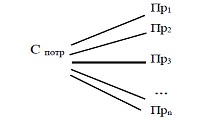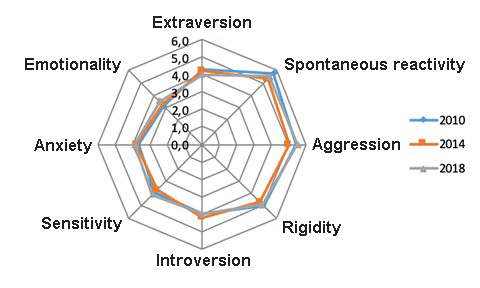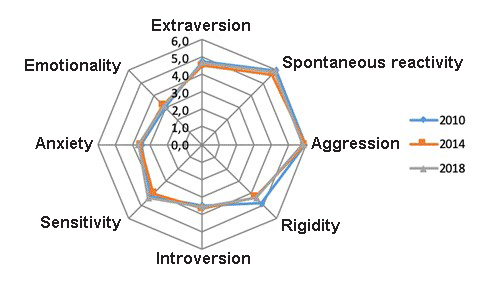Psychological and educatory service to facilitate sporting agenda formation in adolescents in sport training process
ˑ:
Associate Professor, Dr.Hab. E.A. Cherepov1
Associate Professor, PhD G.K. Kalugina1
Postgraduate A.S. Khafizova1
1South Ural State University (National Research University), Chelyabinsk
Keywords: core life mission, adolescents, personality qualities, sport trainings.
Background. As interpreted by many in the modern psychological science, new missions emerge via an individual search of life goals dictated by the actual needs and the associating motivations. The goal setting process is determined by the individual status – that was described by B.S. Bratus’ [1] as the needs-driven one – Cneeds: see Figure 1.

Figure 1. Needs-driven individual status, with the needs spectrum
In this context, the teacher’s guiding role is to offer, on a timely basis, the individual goals and missions to cater for the students’ needs, i.e. offer the mission as soon as there is a motivation.
It is known that the modern research community still differs on the issue of how the core mission for the teenage development period shall be defined and set, with the scientific concepts of the driving teenage development mission being often revised. A.V. Petrovsky [6] came up with the idea that neither of the missions may be strictly defined as the core one for this age period. He believed that it is natural for the missions to change with the physiological and social development stages, conditions and environments in different subgroups as determined by the spectrum on the interpersonal relations inside the groups. A.N. Leontyev [2] underlined in his definition of the core mission that it is “determined by the critical ontogenesis-stage-specific variations in the child’s mental and personality qualities”.
This is the reason why the teachers need to give a special attention to the individual categorical qualities since these qualities at the teenage growth stages are rather volatile and may easily regress to extremities and deviations. Risks of this age period are further aggravated by the lack of positive role models for the children in every socializing process related element and institution, i.e. in their families, adolescent subcultures, mass media service, education environments etc. [8, 12]. The ongoing social crises with the rapid changes in the values and priorities, with the ethical fundamentals in some social strata being notably diluted, are fraught with the risks of a social de-adaptation in many families associated with the imbalances and uncertainties in the traditional relationship system and, as a result, with the growing sociopathic behaviors in the teenage subcultures [8, 9].
Objective of the study was to develop, based on a teenage personaility qualites tests and analyses, a theoretically grounded sport trainig system as a core mission for the adolescent development period.
Methods and structure of the study. Studies [10, 11] of the teenage group relationship standards, personality qualities and their correlations with a special attention to the proneness to extremities, aggression and other deviations – were run on a regular basis once in 4 years. In the 2010 study, the sample was split into Group 1 of junior teenage population (n = 50; Form 5); Group 2 of more senior students (n=50, Form 7) with most of them (n=42) qualified with the risk groups by the school psychologists; and Group 3 of senior students (n = 50, Form 9). In the 2014 study, the sample was split up into Group 1 (n=65, Form 5), Group 2 (n=60, Form 7) and Group 3 (n=50, Form 9). An in the 2018 study, the age groups were much the same: n=50, n=70 and n=65, respectively.
We used the L.N. Sobchik Children’s Questionnaire Test [7] data obtained for the last 8 years to classify and analyze, versus findings of the prior studies [10], the group standards and individual personality qualities with their interactions in the adolescent groups to understand the systemic personality development trends in the national adolescent population.
Results and discussion. The 2010 survey [11] tested most of the teenage sample (92%) with deficiencies in communication with adults, with this finding confirmed by the 2014 and 2018 surveys (90% and 95%, respectively). It was further found that some personality qualities including the spontaneous reactivity, rigidity, introversion, anxiety and emotional volatility – are the most expressed and at the same time susceptible to positive transformations in the adolescents varying from 4 to 6 points versus the normal 0-4 points: see Figure 2.

Figure 2. Form 5 classified personality qualities test data
Extraversion Spontaneous reactivity Aggression Rigidity Introversion Sensitivity Anxiety Emotionality
The Form 7 sensitivity, anxiety and emotionality test data were found within the norm; whilst the extraversion and introversion rates were ranked expressed; and the spontaneous reactivity, aggression and rigidity ranked excessive: see Figure 3.

Figure 3. Form 7 classified personality qualities test data
Extraversion Spontaneous reactivity Aggression Rigidity Introversion Sensitivity Anxiety Emotionality
The excessive spontaneous reactivity and aggression rates were found still excessive in the Form 9 groups – indicative of their emotional sensitivity; whilst the extraversion, rigidity and sensitivity rates were found more expressed: see Figure 4.

Figure 4. Form 9 classified personality qualities test data
Extraversion Spontaneous reactivity Aggression Rigidity Introversion Sensitivity Anxiety Emotionality
It should be underlined that the classified personality qualities are rather sensitive to transformational impacts in the short maturing period of 12 to15 years of age, with risks of regresses in the adolescents tested with deficits of care and attention from adults. The surveys found no proneness to emotional extremities and internal conflicts in connection with the slight variations in the polar qualities (like extraversion and introversion in the 2010 Form 7 rated by 4.3 and 4.0 points, respectively).
If we now agree with the O.V. Lishin’s view [3] of the priority values for the core mission, it may be interpreted as the combination of unregulated goals united by the relevant priorities in perceptions of reality. We believe that such priorities in the teenage period may be provided by the socially appreciated constructive missions with the natural age-specific eclecticism including the expressivity, demonstration, high need for the group appreciation and multidimensional communication. O.V. Lishin emphasizes in his studies [3, 4] that such teenage core missions may include, when the relevant encouraging provisions are put in place, the school education, labor and team sports – when they are supported by sound motivations for self-assertion in the relevant group and, hence, determination and success agenda. Such core missions may imply, when the relevant conditions, institutional forms and environments are available, even the creative and research goals and healthy lifestyles including athletic trainings with competitive accomplishments. Moreover, we would agree with the L.I. Lubysheva’s [5] opinion that modern sports provide an enormous and virtually untapped resource for the teenage population socializing initiatives that may be very efficient. The sport trainings and competitions offer ample opportunities, success motivations and, hence, core missions for adolescents striving to assert themselves in the peer encounters via socially appreciated accomplishments, with the chances to win and assert the own self and even superiority in the relevant social culture.
Conclusion. The study of the adolescent personality qualities found wide variations for a relatively short maturing period in the spontaneous reactivity, rigidity, introversion and emotionality with the active mission finding agenda – that offers a favorable psychological background for focused health agenda formation efforts by the teachers. The study data and analyses demonstrate that sport trainings in adolescent age may evolve into the core personal life mission when they are (1) unregulated too strictly and driven by fair reality-shaping values and priorities; (2) appealing for and appreciated by the relevant social groups; (3) expressly demonstrative for and appreciated by the supporters/ spectators; and (4) associated with the peer communication, friendship, good motivations and self-assertion aspects of great importance for this age group.
References
- Bratus B.S. Lichnostnye smysly po A.N. Leontyevu i problema vertikali soznaniya [Personal meanings by A.N. Leontyev and problem of vertical of consciousness]. Traditsii i perspektivy deyatelnostnogo podkhoda v psikhologii [Traditions and perspectives of activity approach in psychology]. Moscow: Mysl publ., 1996, 291 p.
- Leontyev A.N. Izbrannye psikhologicheskie proizvedeniya [Selected works in psychology]. Moscow: Nauka publ., 1983, vol. 1, 385 p.
- Lishin O.V., Chernysheva O.A., Yashchuk S.L. Podrostok v shkole: sistema otnosheniy, motivatsiya deyatelnosti [Teenager at school: system of relationships, motivation for activity]. Mir psikhologii, 2001, no. 3, pp. 233-246.
- Lishin O.V. Diagnostika urovnya sformirovannosti obshchestvenno poleznoy deyatelnosti kak sposob psikhologicheskoy kharakteristiki vospitatelnogo protsessa [Diagnostics of level of development of community services to give psychological characteristics of educational process]. Psikhologicheskiy zhurnal, 1990, vol. 11, no. 4, pp. 98-106.
- Lubysheva L.I. Sportivnaya kultura v shkole [Sports culture at school]. Moscow: TiPFK publ., 2006, 174 p.
- Petrovsky A.V. Lichnost. Deyatelnost. Kollektiv [Personality. Activity. Team]. Moscow: Politizdat publ., 1982, 255 p.
- Sobchik L.N. Iskusstvo psikhodiagnostiki [The art of psychodiagnostics]. St. Petersburg: Rech publ., 2014, 160 p.
- Tereshchenko V.V. Podrostok v prostranstve ego vzrosleniya i opredeleniya [Teenager in his growing up and self-actualization environment]. Nauchnye problemy gumanitarnykh issledovaniy. Pyatigorsk, 2009, no. 8, pp. 106-111.
- Feldstein D.I. Trudny podrostok [Troubled teenager]. Voronezh: Modek publ., 2008, 208 p.
- Cherepov E.A. Metapredmetnaya paradigma zdoroveformiruyushchego obrazovatelnogo prostranstva sovremennoy obshcheobrazovatelnoy organizatsii [Meta-disciplinary paradigm of health-forming educational space of modern general educational organization]. Vestnik YuUrGU ser. 'Obrazovanie, zdravookhranenie, fizicheskaya kultura', 2015, vol. 15, no. 4, pp. 5-13.
- Cherepov E.A. Osobennosti dinamiki individualno-lichnostnykh svoystv v podrostkovom ontogeneze [Specific features of dynamics of individually-personal features in teenage ontogenesis]. Teoriya i praktika fiz. kultury, 2011, no. 4, pp. 51-53.
- Catellani N., Ilyasov D., Cherepov E., Sevryukova A., Selivanova E., Kudinov V., Nikolov N. Development of psychological readiness in physical education teachers for the implementation of inclusive education. HUMAN. SPORT. MEDICINE, 2018, no. 18(1). Рр. 125-137.
Corresponding author: cherepov.e@mail.ru
Abstract
The study makes an attempt to facilitate formation of a theoretical and practical awareness of the potential sport careers in adolescents, with the sport practices viewed as a potential foundation for future sport careers. We used the L.N. Sobchik Children’s Questionnaire Test data obtained for the last 8 years to classify and analyze the group standards and individual personality qualities and their interactions in the adolescent groups to understand the systemic personality development trends in the national adolescent population. Some personality qualities including the spontaneous reactivity, rigidity, introversion and emotional volatility were proved to be the most susceptible to positive transformations in adolescents. The study data and analyses demonstrate that sport trainings in adolescent age may evolve into the core personal life mission when they are (1) unregulated too strictly and driven by fair reality-shaping values and priorities; (2) appealing for and appreciated by the relevant social groups; (3) expressly demonstrative for and appreciated by the supporters/ spectators; and (4) associated with the peer communication, friendship, good motivations and self-assertion aspects of great importance for the age group.


